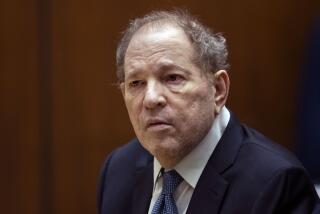Juveniles Are Among Cuba War Detainees
Military authorities at the U.S. Naval Base on Guantanamo Bay, Cuba, have discovered that several of their war-on-terror detainees are juveniles and have begun providing them special care while trying to sort out what intelligence value, if any, the youths might have.
The “handful” of juveniles, described as between 13 and 15, were declared “enemy combatants” when they were arrested fighting against U.S. troops in Central Asia. They were flown to the detention camp earlier this year and, after a detailed medical examination, were determined to be youngsters, Army Lt. Col. Barry Johnson said Tuesday.
Because of their special situation, Johnson added, the juveniles have been removed from individual cells at Camp Delta and placed in a group setting away from the other 660 detainees. They also are being given extra mental health counseling, and efforts are underway to contact their home nations and, presumably, their parents.
But, Johnson stressed, there is no intention at this point of simply returning them home before U.S. interrogators can thoroughly examine the youths. U.S. officials want first to determine that they would no longer be a threat to the United States if they were released.
In addition, there has been no decision that, as juveniles, they automatically would not be sent to a military tribunal and, possibly, sentenced to more prison time.
“We did have to adapt and make some special considerations and look at how we’re going to handle them with regard to the rest of the detention population,” Johnson said.
“But we have to face the hard reality that there are some places in the world where child combatants are used to further a cause.”
Thomas Wilner, a Washington lawyer who is representing the families of a dozen adult Kuwaitis detained at Guantanamo Bay, said it is deplorable that none of the inmates, including the juveniles, has been given access to a lawyer or been apprised of any charges against them. “It makes it all the more important for the need for some impartial body to review these detentions,” Wilner said. “How would any of us feel if one of our children were held this way, with no ability even to talk to him?”
The acknowledgment that some of the detainees -- numbered at fewer than a half dozen -- are juveniles comes after the camp has been operating for more than a year as the central holding facility for prisoners from the war in Afghanistan. The prisoners’ fates have yet to be determined.
The Pentagon has published some regulations for eventually holding military tribunals and trying some of the detainees, but no announcement has come on who might be tried and for what offenses, even though the first inmates began arriving in January 2002.
As the detention camp grows, tensions and deep frustrations have settled in at the Caribbean facility. There have been sporadic hunger strikes, and two dozen detainees have attempted suicide, mostly by trying to hang or strangle themselves.
Authorities soon will decide what to do with one detainee who severely injured himself in an attempted hanging. The man was reported to have been in a coma.
“He is back in the detention hospital,” Johnson said of the detainee, who hurt himself Jan. 16. “He is undergoing evaluation to determine what disposition should be taken with him, and what his prognosis is for the future.
“But he is not on life support. He breathes on his own.”
Further complicating the uncertainty at the base, the U.S. Court of Appeals in Washington ruled last month that none of the detainees has the right to meet with lawyers or seek due process in the courts.
The appellate court based its finding on the fact that the detainees are not Americans and are not housed within the borders of the United States -- all of which leaves them at the mercy of their U.S. handlers.
The juveniles began arriving after the first of this year from a holding area at a U.S. air base in Bagram, Afghanistan.
“They looked like teenagers, like young adults,” Johnson said. “But often, ages are difficult to determine because people don’t always know what their ages are, necessarily. You get a wide range of answers.”
To solve the dilemma, authorities turned to the Armed Forces Institute of Pathology to perform a series of medical tests on the youngsters to estimate their ages.
Johnson said the teenagers were immediately taken from individual cells with the general adult inmate population and placed in a separate confinement area where they can intermingle. Isolated in that way, authorities also can provide special physical and mental health care for the teenagers, and also give them educational assistance and special recreation. And guards trained in watching juvenile inmates have been assigned to the unit.
Also, contacts are being made with the boys’ home countries to notify those government officials, and leave it to them to decide whether the teenagers’ parents should be alerted.
But, Johnson said, the teenagers are still classified as enemy combatants, and none of them has completed the interrogation process or been deemed no longer a threat to America.
“Very unfortunate situations ... bring them here,” he said. “The fact that children and juveniles are being used as combatants is a reality in many parts of the world.
“So we’re going to do the right thing in taking care of their special needs. But that doesn’t necessarily lessen the intelligence value they may have in assisting us fight the global war on terrorism.”
More to Read
Start your day right
Sign up for Essential California for news, features and recommendations from the L.A. Times and beyond in your inbox six days a week.
You may occasionally receive promotional content from the Los Angeles Times.







